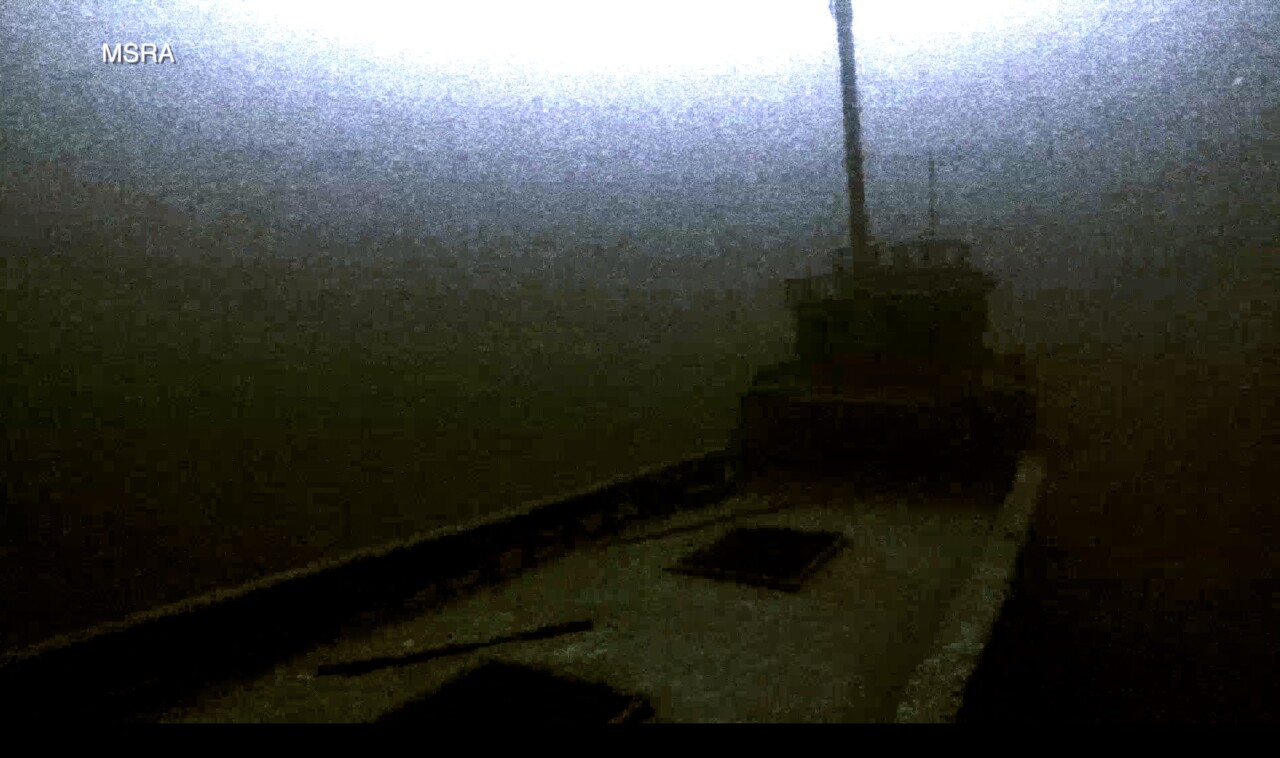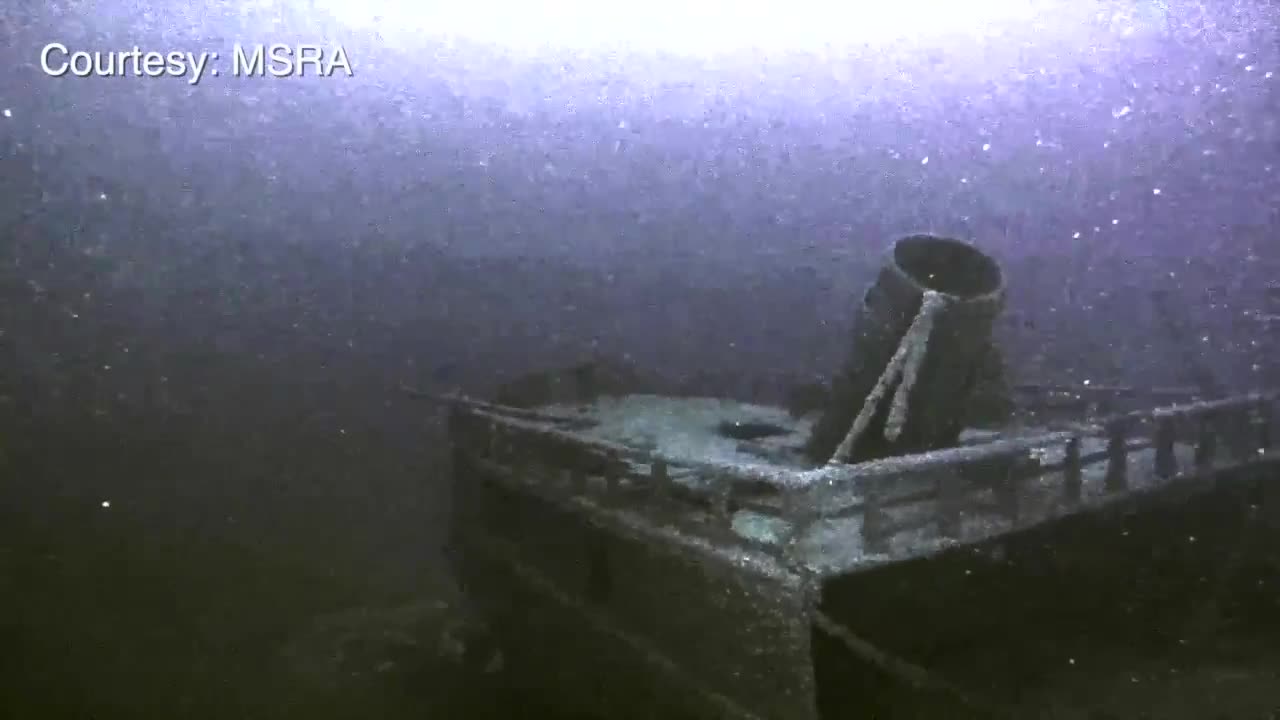HOLLAND, Mich. — Explorers from the Michigan Shipwreck Research Association (MSRA) have discovered and identified the remains of the steam barge Milwaukee, which sank in 1886, about 40 miles west of Holland, Michigan.
According to the MSRA, the discovery was made in June 2023 using side-scan sonar, marking the 19th shipwreck the group of explorers has found during their decades of work on the Great Lakes.
Members of the MSRA Board of Directors, which included Valerie and Jack van Heest, Craig Rich and Neel Zoss, spent the balance of the summer working to film the wreck so they could confirm its identity, Valerie tells FOX 17.
"It was just an ordinary ship going about its everyday job," Valerie van Heest, award-winning author, historian, museum exhibit designer and director of the Michigan Shipwreck Research Association (MSRA), said. “But, it was at the wrong place on Lake Michigan at the wrong time.”

“The discovery [of the Milwaukee] happened faster than some of our past discoveries,” Valerie said. “It was actually on our second day on Lake Michigan.”
As the group was moving slowly on the lake where they believed the Milwaukee met its fate, a very large object suddenly appeared on the side-scan sonar, Valerie said.
“It wasn’t clear,” Valerie added. “We couldn’t tell if it was a ship, but it was definitely something big on the bottom, surrounded by nothing but sand."
“So, that was the ‘bingo moment’ — we knew we had found it.”
With the coordinates of their target now in hand, Valerie says her group went back to Holland, re-equipped their boat with a remote-operated vehicle (ROV), then ventured back out to the location on Lake Michigan where they’d made the discovery.
“The object is in 360 feet of water, so without our experienced, mixed-gas divers available, we needed to get some eyes on the target to see if it’s what we believe it to be,” said Valerie.
Jack van Heest, Valerie’s husband, built the ROV that the group sent down to the lake bottom to explore and document the discovery.
“We were kind of flying by the seat of our pants just getting down there,” Jack recalled. “We had to make sure we weren’t going to get tangled up on anything.”
Once the ROV reached the lake bottom, Jack says he navigated it toward the target. It didn’t take long for a ship to start filling the screen.

“Suddenly, we saw the stern and railings,” Jack said. “Then we saw the smokestack.”
Valerie said one of the "smoking guns" that would help lead the group to identifying this shipwreck as the Milwaukee would be finding significant damage on the portside, because that’s where another ship — the C.Hickox — collided with it during heavy fog, leading to the Milwaukee’s sinking.
As the ROV moved along the portside of the ship, Jack said he could see damage that matched the group’s research.
“The only photo we had of the Milwaukee was taken before it was converted from a passenger steamer to a lumber-carrying barge,” Jack said. “The Milwaukee underwent many modifications during the conversion, so there were areas of the ship that weren’t on the photo.”

During her research, Valerie says she learned that the Milwaukee’s pilot house had been totally redone and it was pushed closer to the bow of the ship. She says she also learned that the captain and crew of the Milwaukee rigged a “canvas jacket” by stretching the sail over the damaged side of the ship with the hope of reducing the onrush of water.
Armed with the history of what happened during the sinking, the explorers knew to look for the canvas straps that may have been used. As they continued running the ROV near the wreck site, they found them laying next to the ship on the lake bottom, checking off another box in determining they had found the wreck of the Milwaukee.
“That was exciting to see,” said Jack.
Along with the canvas straps, Jack was able to capture ROV footage of additional identifiable items on the ship before bringing the tethered robot back to the surface.
“We probably have logged about 400 hours into this project,” Jack said. “But it’s all worth it when you can confirm what you found, and we were able to do that with this discovery."
Before its loss, the Milwaukee enjoyed a career plying the Great Lakes for 18 years. The Northern Transportation Company of Ohio commissioned the 135-foot ship to join its growing fleet of passenger steamers that ran from Ogdensburg, New York, to Chicago with many stops in between, according to a news release put out by the MSRA.
“Fourteen years into her service, around 1873, the Milwaukee was re-purposed from a passenger steamer into a barge,” Valerie said. “The ship was eventually sold and began a new career on Lake Michigan carrying all manner of cargo across the lake.”
Valerie went on to say that on the night of July 9, 1886, the Milwaukee left Chicago after unloading a cargo of lumber and set a course for Muskegon for another load. An almost identical ship, the C. Hickox, operating for a different Muskegon lumber company, left Muskegon that evening for Chicago with a load of lumber.
“The lake was calm that night,” said Valerie as she continued to recount the historical records of what happened. “Both ships sailed such an exact course, that at about midnight, they were both off Holland and bearing straight for each other.”
Valerie adds that a thick fog began rolling in and neither ship could see each other’s lights.
“That’s when three bad things happened in succession,” Valerie said. “Along with the fog, Captain O’Day of the C. Hickox turned his ship, but when he tried to blast his steam whistle, the pull chain broke. Captain Armstrong of the Milwaukee froze and was unsure of what to do. Armstrong made a fast turn, but the two ships were traveling too fast."
“The C. Hickox plowed into the side of the Milwaukee, nearly capsizing the ship.”
All hands survived, escaping on lifeboats.
Two hours later, the Milwaukee slipped below the surface and was never seen again for 137 years until summer 2023 when the MSRA made its discovery.
“A shipwreck is a tangible connection to history,” said Valerie. “Michigan wouldn’t be here if it weren’t for the water."
“What keeps us going is always the next one.”
Valerie says they have several more targets on their bucket list to check in Lake Michigan in 2024. Expedition season begins late spring, early summer.
READ MORE: Father, 6-year-old daughter stumble upon century-old shipwreck in Lake Michigan
Follow FOX 17: Facebook - X (formerly Twitter) - Instagram - YouTube




